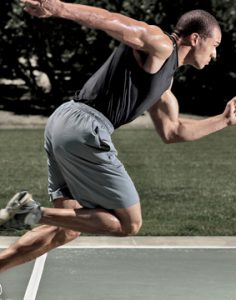A question that comes up very frequently is "How should I train"? Obviously, there are an endless number of possible training methods. Some trainers focus on interval training while others focus more on volume training at low intensity.
I'll give you a “scoop” right away: anything can work!
 In this blog, I will focus on training for running. If you're training just to keep your cardiovascular health healthy, the science is relatively clear: you can get a lot of benefits in a relatively short period of time from intervals at fairly high intensity.
In this blog, I will focus on training for running. If you're training just to keep your cardiovascular health healthy, the science is relatively clear: you can get a lot of benefits in a relatively short period of time from intervals at fairly high intensity.
If you are not currently running and would like to improve quickly, what type of training should you favor?
A small study published in 2010 teaches us that there is almost no difference between these two workouts, practiced 3 times a week:
- Three workouts per week. On Mondays the workout was 4-7 times 2 minutes, Wednesday 3 to 5 times 3 minutes and Fridays 2 to 5 times 4 minutes. The rest periods were the same length as the intervals;
- Three workouts per week. Initially, 16 minutes at 75% VO2 max and progress to 40 minutes at 75% VO2 max.
The two workouts caused similar improvements on the VAM runners in both groups. Note, however, that the group that did interval training did not train for as long. In this sense, the training was more efficient because it gave the same results in less time.
Note also that the subjects were not runners, but active people. If you are sedentary at the moment, in order to limit the risk of injury, I would suggest starting with low intensity training.
Here are the recommendations that we could make for beginners:
If you are sedentary and want to improve your health and practice low impact sport (for example, cycling), practicing this sport in intervals will be more effective.
cycling), practicing this sport in intervals will be more effective.
If you are sedentary and want to improve your health with running, my suggestion would be to start with a split program like the one at the Clinique du Coureur, performed at low intensity, with a view to reducing the risk of injury.
If you are already active and play sports that involve running, such as soccer or tennis, you can start with interval training or continuous training, both seem effective.
If you are already active and play sports that contain little running, such as diving, swimming, or hockey, you should start with a low-intensity training program, but you can probably progress quickly to a workout that contains intervals if desired.
If you like this type of article, I suggest you take our 10 free online courses. In addition, you will automatically be subscribed to our weekly newsletter. To receive the 10 lessons, click here!



Hi Daniel, thank you for your precious articles… ..a question has been bothering me for some time: considering that there are more and more runners and that more and more of us are entering our fifties (hey yes) considering also that tendons lose their elasticity with age. Would it be good to have suitable interval programs 50 years + and if so maybe also a capsule in our training.
Thank you
Hello,
Very good point. After the interval series, I will be doing an article on running for people 50 and over. In the meantime, I can tell you that I feel like weight training is probably pretty important for older runners. I complete my research and I post the article at the end of January / beginning of February.
I second Robert's comment. There is very little information on the web for 50 and over ...
We're working on it!
I mention (in English) the book by Joe Friel "Fast after 50" of which you have a certain overview in his blog (keyword "blog joe friel aging"). Curiously (or not for that matter), it also mentions the benefits of interval training in weekly training to counter the effects of aging but also of a microcycle over 10 days instead of a week. I let you discover or analyze, I am sure that Daniel will know how to make a synthesis as he knows how to do it so well.